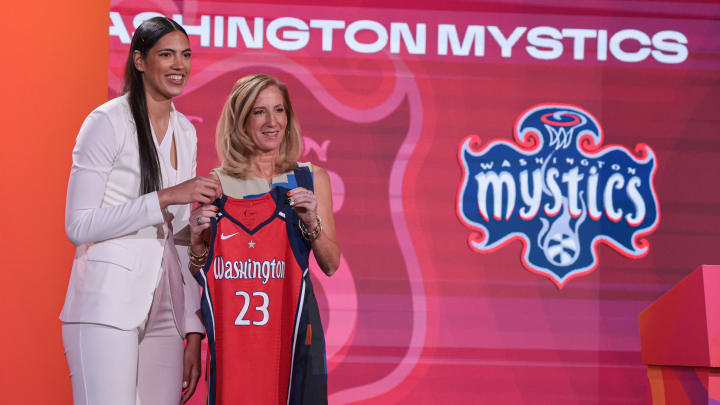SI:AM | The Wings’ Big Swings in the WNBA Draft

Good morning, I’m Dan Gartland. Are you ready for the chaos of the NBA play-in tournament?
In today’s SI:AM:
🎙️ The voices of the NBA postseason
📝 The Ravens’ puzzling signing
If you're reading this on SI.com, you can sign up to get this free newsletter in your inbox each weekday at SI.com/newsletters.
The WNBA’s next crop of stars
The first three picks in last night’s WNBA draft went just as most people expected they would. Then things got a little weird.
South Carolina’s Aliyah Boston went first to the Fever, the Lynx took Maryland’s Diamond Miller and the Wings selected Maddy Siegrist from Villanova with the third pick. (Credit to Clare Brennan for nailing those picks in her mock draft.)
Boston was the no-brainer choice for the No. 1 pick. She was the best player on a South Carolina team that won the 2022 national championship and went undefeated this season before losing in the Final Four to Caitlin Clark and Iowa. The Fever are in need of a serious boost after a dreadful few seasons. Indiana went 5–31 last year, tying the record for most losses in a season, and hasn’t made the playoffs since ’16. In Boston, though, the Fever are getting a defensive stalwart who fits the organization’s reputation for playing tough defense.
Miller is big for a guard at 6'3" and was the offensive engine for a Maryland team that reached the Elite Eight this year, but she also plays tough defense, averaging 2.1 steals and 1.3 blocks per game as a senior. Siegrist is an elite scorer, having led all of Division I (men and women) with 29.2 points per game this season. After the Wings traded away their second- and third-leading scorers (Marina Mabrey and Allisha Gray) this offseason, Dallas needed a new scoring threat to place alongside Arike Ogunbowale.
The pick used to select Siegrist was actually acquired from the Dream in the Gray trade. Dallas also got a 2025 first-rounder in the deal, but the Wings turned around and traded that pick away last night, sending it to the Mystics (along with a ’24 second-rounder) in exchange for the draft rights to Stephanie Soares. The Wings are taking a flier on Soares, who played only 13 games at Iowa State before tearing her ACL in early January. It’s the second time Soares has torn her ACL. There’s plenty to like about her—she’s 6'6" with a capable three-point stroke—but it’s a risky move for the Wings. Soares dominated at the NAIA level before transferring to Iowa State but has limited D-I experience, and her health is a question mark. The Wings are giving up a first-round pick in a draft two years from now that could be loaded, with the last crop of players granted an extra year of college eligibility due to the pandemic potentially set to go pro. Soares has potential, but there’s risk involved, especially considering there should be a wealth of talented players available in ’25.
The other thing that makes Dallas’s trade for Soares surprising is the Wings already had a whole bunch of picks in the first round. They selected Siegrist at No. 3, traded for Soares at No. 4, picked UConn’s Lou Lopez Sénéchal at No. 5 and then took Maryland’s Abby Meyers at No. 11. In a league where draft picks—even first-round picks—struggle to make rosters, the Wings just gave themselves some difficult decisions to make.
Two players also watched themselves fall further down the draft board than anticipated. One was Stanford guard Haley Jones, who nearly averaged a double double this season with 13.5 points and 9.0 rebounds per game, while also pitching in 4.0 assists per game. She was one of the best players on a team that earned a No. 1 seed in this year’s NCAA tournament, but concerns about her shooting ability (she made just three of 32 three-point attempts this season) led her to fall out of the lottery to the Dream at No. 6.
The biggest shock, though, was South Carolina guard Brea Beal fell all the way to the 24th pick in the draft, the last pick of the second round. (Brennan had her at No. 7 in her mock draft.) Beal, who was taken by the Lynx, was one of five Gamecocks selected. She was a Naismith Defensive Player of the Year finalist and one of 15 players invited to attend the draft in person, but had the unfortunate distinction of being the last player in the room in Manhattan waiting to hear their name called.
The best of Sports Illustrated

- Today’s Daily Cover is Steve Rushin’s story on how Stan and Jeff Van Gundy became two of the NBA’s most recognizable voices.
- Chris Mannix explains how this unpredictable NBA postseason is the result of commissioner Adam Silver’s pursuit of NFL-style parity.
- Albert Breer has some reporting on how the top of this month’s NFL draft could play out.
- Kevin Hanson’s latest NFL mock draft, perhaps not surprisingly, has three quarterbacks going with the first three picks.
- Conor Orr wonders exactly what the Ravens are trying to achieve with the signing of Odell Beckham Jr.
- The Cardinals are reportedly receiving lots of offers for the No. 3 pick in the NFL draft.
- The WNBA is providing charter flights for more games this season.
- Former Cardinals coach Kliff Kingsbury is reportedly joining Lincoln Riley’s staff at USC.
The top five...
… things I saw yesterday:
5. Claude Giroux and Joe Pavelski each scoring their 1,000th career points. (Only 97 players in NHL history have reached that milestone.)
4. Sabres rookie goaltender Devon Levi’s performance in a shootout against the Rangers. (Levi was playing for Northeastern University a month ago.)
3. Brandon Lowe’s home run in the eighth inning to lead the Rays to their 10th straight win.
2. The Orioles’ new home run celebration prop, which is called, depending on who you believe, either the “dong bong” or “homer hose.”
1. The two physics-defying infield hits by the Mets’ Luis Guillorme and Tomás Nido—in the same inning.
SIQ
With home runs on April 11, 1959, and April 12, 1965, who is the only pitcher to hit two Opening Day homers?
- Bob Lemon
- Don Drysdale
- Bob Gibson
- Warren Spahn
Yesterday’s SIQ: In 1945, due to a player shortage amid World War II, the NFL’s Brooklyn Tigers merged with the team from Boston that went by what name?
- Braves
- Bulldogs
- Reds
- Yanks
Answer: Yanks. Can you believe that? A team in Boston named after the Red Sox’ most hated rivals.
The Boston Yanks entered the NFL in 1944, filling the city’s pro football void left when the team now known as the Commanders moved to Washington in ’37.
The franchise’s owner, Ted Collins (best known for being the manager of singer Kate Smith), was a New York native and wanted to put a team in Yankee Stadium. The Giants, who at the time were still playing across the river from Yankee Stadium at the Polo Grounds, argued Collins would be encroaching on their territory and so Collins’s team was placed in Boston. But he kept the Yanks nickname.
After their inaugural season, the Yanks merged with the Brooklyn Tigers (formerly known as the Dodgers). The combined team, known simply as the The Yanks, played one season, with four home games at Fenway Park and one at Yankee Stadium. Collins eventually got his wish of playing in Yankee Stadium on a regular basis when the team moved to New York in 1950 as the New York Yanks, but they lasted only two seasons.
